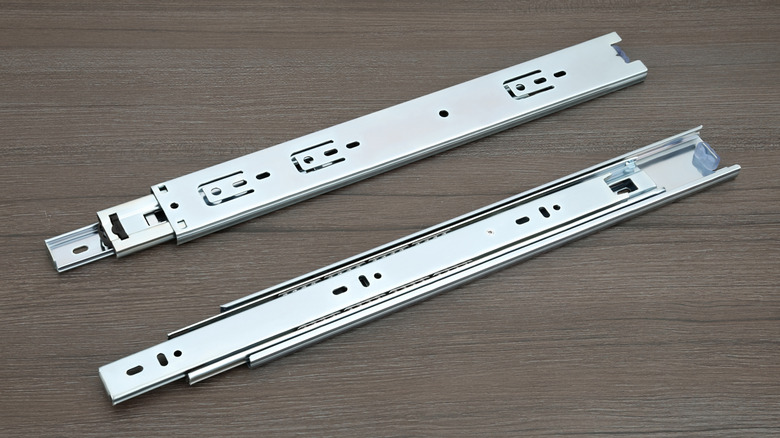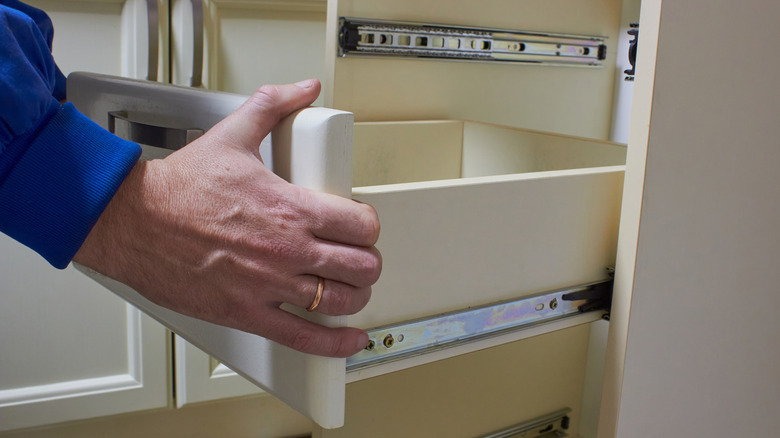Mistakes You're Making When Installing Drawer Slides
Whether you're building a piece of furniture from scratch or replacing hardware on an existing drawer, installing the drawer slides correctly is essential. Even a small mistake could render the drawer useless, or at least make it a pain to open and close. Common mistakes that happen when installing drawer slides include using the wrong type of slides, measuring incorrectly, not leveling the slides, misaligning them, or not using enough screws to secure them. Even a small miscalculation in the measurement or alignment could make your drawer refuse to stay closed or drag when you open or close it.
Drawer slides are the hardware that allows you to pull a drawer out and push it back in smoothly. There are different types of drawer runners that operate uniquely and offer distinct benefits. You'll find them in kitchen cabinetry, desks, and other pieces of furniture with drawers. When you buy furniture, it usually already has the drawer slides installed with the drawers in place. However, you may need to replace the slides if they become damaged. If you're building a piece of furniture from scratch, you might need to install slides if you add drawers to the piece.
Don't let the potential mistakes cause you to avoid doing the project yourself. Once you're aware of the potential issues, you can prepare with the right tools and techniques to choose, measure, and install the hardware correctly. Tools like installation jigs can also make the job easier and more accurate. The specific techniques you use will vary depending on the type of drawer slides you're installing. However, many mistakes are universal regardless of the slide type.
Getting the type or size of drawer slides wrong
Drawer slides come in side-mount, center-mount, and undermount styles, and each type works well for different situations. Center-mount and undermount drawer slides both attach to the bottom of the drawer for concealed options. They leave more space on the sides, so you can have a wider drawer, but the box might be slightly shallower to accommodate the slides. Center-mount hardware uses a single slide down the center, so it can't handle as much weight as undermount slides, and you can't usually get a full-extension option. Side-mount slides offer a durable option when you need your drawer to hold a lot of weight. However, they don't always slide as smoothly as undermount slides. If you're replacing old slides, you'll likely use the same type. If you're building a new drawer, consider which features you need.
Getting the length correct is also essential for the drawer's functionality. If the drawer slide is too short, it won't allow you to open the door completely, which can limit access to the contents. If you go too long with the slide, you won't be able to fit it within the cabinet space. To measure drawer slides, you need to measure the drawer's length and depth. When measuring the length, don't include the drawer face. For side-mount slides, you'll also need to measure the clearance between the side of the drawer and the side of the cabinet box to make sure the slide will fit. You'll get the most accurate measurements if you remove the drawer from the cabinet first. Double-check your measurements and measure both sides of the drawer for accuracy.
Failing to level, align, and secure the slides properly
Starting with the correct hardware is essential, but you also need to attach it correctly to the drawer and cabinet. Drawer slides have two parts: one attaches to the cabinet and one attaches to the drawer. If the two parts of each slide aren't aligned precisely, the drawer won't slide smoothly and might jerk when you use it. An unlevel drawer slide installation could make the drawer difficult to pull out, or the drawer might open on its own. Installing level, aligned drawer slide components is easier when the drawer itself is perfectly square.
Using a drawer slide installation jig makes the job easier. It clamps to the front of the cabinet and serves as a guide for installing the part of the slide that attaches to the cabinet. Then, you can flip the jig around so it sits outside of the cabinet. It then becomes a guide for attaching the part of the slide that you screw to the drawer. You can make spacers or guides using a piece of plywood for a similar effect. Checking the installation with a level verifies that you installed the slides evenly.
Once you have the slides level and aligned, you need to anchor them securely. The drawer slide should recommend how many screws to use — follow those guidelines for the size and number of screws to ensure you attach the parts securely. If you don't the parts could loosen over time, even if they seem secure initially. Loose slide components could make the drawer uneven or wobbly, so make sure the screws are secure without over tightening them.


